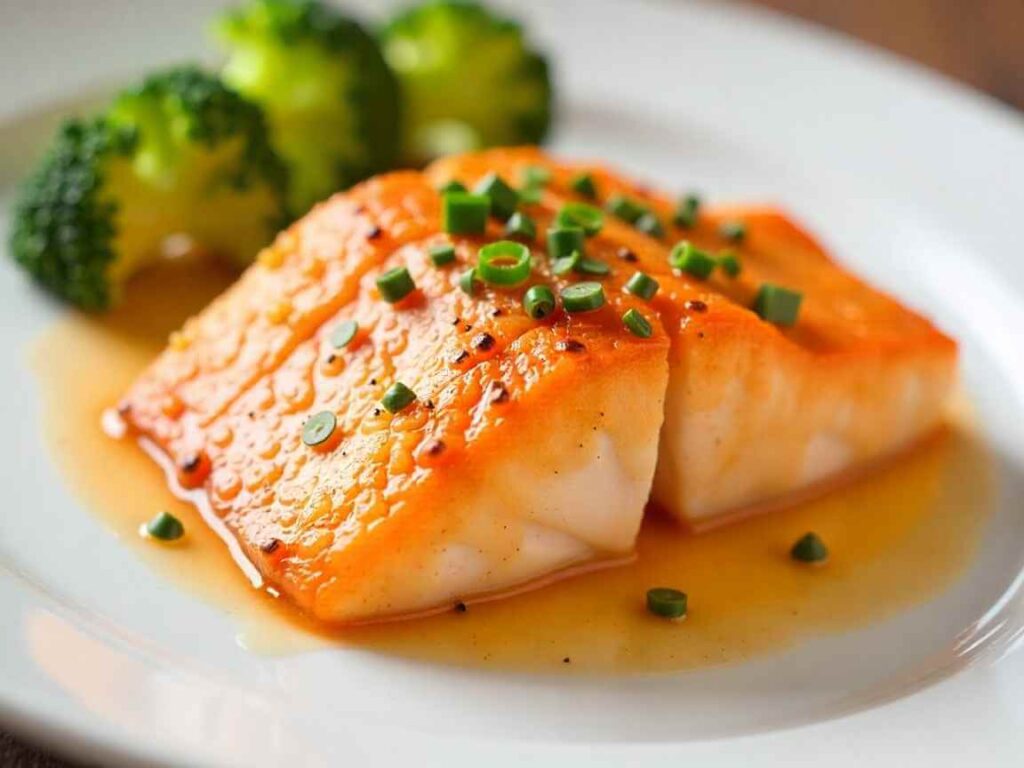Swordfish is a popular choice at FultonFishMarket.com, and for good reason. Its meaty texture, rich flavor, and versatility make it a favorite among seafood fans. Swordfish is easy to prepare and comes with many health benefits. In this guide, you’ll learn about swordfish’s features, where it lives, how it tastes, its health perks, and the best ways to cook it.
What Is Swordfish?
Swordfish (Xiphias gladius), sometimes called “Broadbills,” is a large, strong fish found worldwide. Its long, pointed sword can be up to a third of its body length. Swordfish are known for their strength in the water and are popular with seafood lovers. They migrate long distances and can live in both warm and cool ocean waters.
These magnificent creatures typically reach lengths of 10 feet, but some have been known to grow over 15 feet long and weigh as much as 1,400 pounds. (North Atlantic Swordfish, n.d.) Despite their massive size, swordfish are incredibly fast swimmers and can reach speeds of up to 50 mph. (The Fastest Fish, n.d.) Their iconic sword, made of bone, is primarily used to slash at schools of fish, making it easier for the swordfish to hunt and capture prey.

Even without teeth, adult swordfish are skilled hunters. They eat a variety of fish such as haddock, cod, and squid, along with deep-sea creatures like viperfish and lanternfish. Swordfish can dive more than 2,000 feet while searching for food. (How Deep Do Swordfish Dive? Habitat & Record Depths, n.d.) Their varied diet helps them live in many different ocean environments.
Unique Features of Swordfish
Swordfish have a special ability to warm their eyes and brains using unique blood vessels called countercurrent exchangers. (Carey & F.G., 1982) This helps them live in cold, deep waters where other predators might have trouble. By keeping their senses warm, swordfish can see well and react quickly, which helps them hunt in dark, deep areas. (Fritsches et al., 2005)
Because of their size, strength, and speed, adult swordfish do not have many natural enemies. Still, killer whales and big sharks like the shortfin mako sometimes hunt them. (Swordfish – Wikipedia, n.d.) Some predators have even been found with broken swordfish bills stuck in their heads, showing how risky it is to attack a swordfish. A 1,000-pound swordfish with a 4-5 foot bill, swimming at 50 mph, can be very dangerous.
Where Are Swordfish Found?

Swordfish live in oceans all over the world, especially in the Atlantic and Pacific. In the Northeast, they show up near Block Island in late May or June and are common off Montauk in summer and fall. People used to catch swordfish with harpoons, but now most are caught with longline boats.
NOAA’s 2017 stock assessments show that North Atlantic swordfish are not overfished and are not being overfished, so they are a sustainable seafood option. (The Surprising Story of Swordfish You May Not Know, 2017) This means swordfish should stay plentiful for years to come.
What Does Swordfish Taste Like?

Swordfish is a tasty and versatile fish that many cooks love for its rich flavor and meaty texture. Its firm, steak-like feel makes it great for grilling, broiling, or pan-searing. The meat is juicy and flavorful, and people often compare it to tuna because of its similar texture.
Swordfish meat can be creamy white or a deep orange, which is called “pumpkin swordfish.” The orange color comes from the fish eating lots of shrimp and crustaceans, which have carotenoids that tint the meat. This is like how flamingos turn pink from the carotenoids in their food.
Some people love the taste of pumpkin swordfish, but the flavor difference is actually small. A well-cooked regular swordfish can taste just as good. Still, pumpkin swordfish usually costs more because of its color and reputation for better flavor.
Health Benefits of Swordfish

Swordfish is not only tasty but also full of nutrients. It is high in quality protein, making it a good choice for those who want more protein in their diet. Swordfish also has vitamin B12, niacin, and omega-3 fatty acids, which are good for your heart and brain.
According to the University of California, swordfish is a good source of selenium, an essential mineral with antioxidant properties. Selenium has been linked to cancer prevention and supports the immune system, making swordfish a healthy addition to your diet. (Swordfish: A Zesty Take on Swordfish, n.d.) Furthermore, swordfish is low in fat, cholesterol-free, and low in calories, which makes it an ideal choice for individuals following low-fat diets like Keto, Paleo, or Whole30. (Calories in Swordfish and Nutrition Facts, n.d.)
However, swordfish can have mercury, a heavy metal that can build up in the body over time. (Why should swordfish be avoided?, n.d.) Even though swordfish is healthy, pregnant women, young children, and people with some health issues should eat less of it. As with all fish, it’s best to eat swordfish in moderation.
Best Swordfish Recipes

Swordfish is easy to cook in many ways. You can grill, bake, or sear it, and it turns out well with different methods. Here are a couple of our favorite recipes to try:
Grilled Lemon & Garlic Swordfish Kabobs
Grilled swordfish and vegetable skewers make a great summer meal. Marinate the swordfish in olive oil, lemon juice, garlic, and oregano for a fresh flavor. Thread the fish and vegetables onto skewers and grill until you see nice grill marks. Serve with rice or in pita bread with extra lemon for a Mediterranean-style dish.
Baked Swordfish
If you want an easy and tasty way to cook swordfish, try baking it. This recipe is quick and perfect for a special meal. Just season the fish with your favorite herbs and spices, then bake until it’s flaky and tender. It’s a great choice for busy nights when you want a healthy dinner without much effort.
Cooking Tips for Swordfish
When cooking swordfish, be careful not to overcook it. The best results come when the fish reaches an internal temperature of 140°F (60°C). This keeps the swordfish moist and tender instead of dry or tough.
Here are a few tips for cooking swordfish:
- Grilling: Heat your grill to medium-high. Brush swordfish with olive oil and season with salt, pepper, and your favorite spices. Grill each side for 4-5 minutes or until it’s cooked the way you like.
- Pan-searing: Warm a skillet over medium-high heat and add some olive oil. Sear the swordfish for 4-5 minutes on each side until it gets a golden-brown crust.
- Baking: Preheat your oven to 400°F (200°C). Put the swordfish on a baking sheet and bake for 15-20 minutes, depending on how thick the fish is.
Conclusion
Swordfish is a great pick if you want a hearty, tasty fish that’s simple to cook and full of nutrients. Its firm, steak-like texture and rich flavor make it perfect for grilling, baking, or searing. Whether it’s for a family meal or a special event, swordfish is sure to please. It’s high in protein and omega-3s, also making it a healthy choice for your diet.
For those seeking a sustainable, delicious seafood option, swordfish remains a top choice. For its fascinating hunting, if you want a tasty and sustainable seafood option, swordfish is a great choice. Its unique hunting style and rich, buttery flavor make it a favorite for seafood fans everywhere. Next time you visit the market, pick up some swordfish and enjoy a meal that’s both delicious and healthy.



















